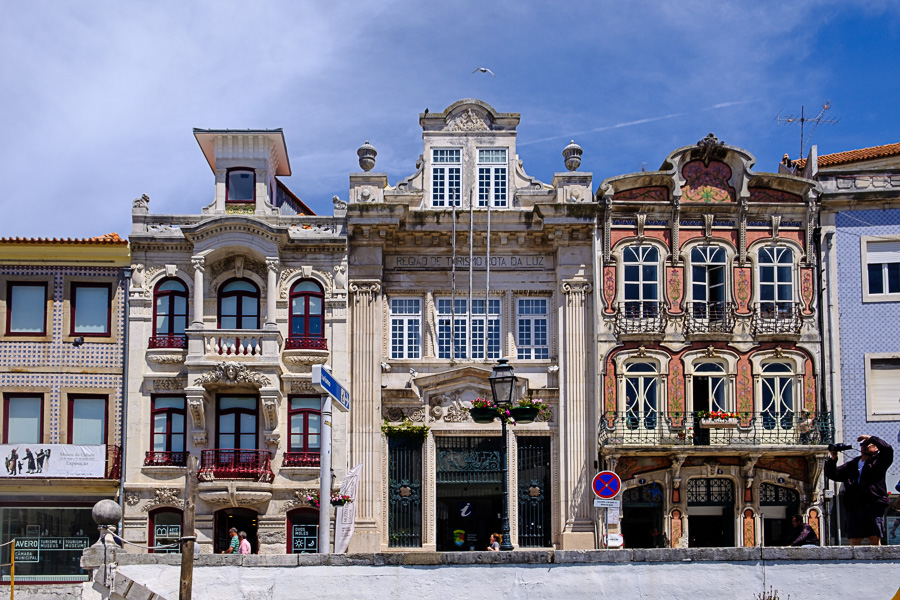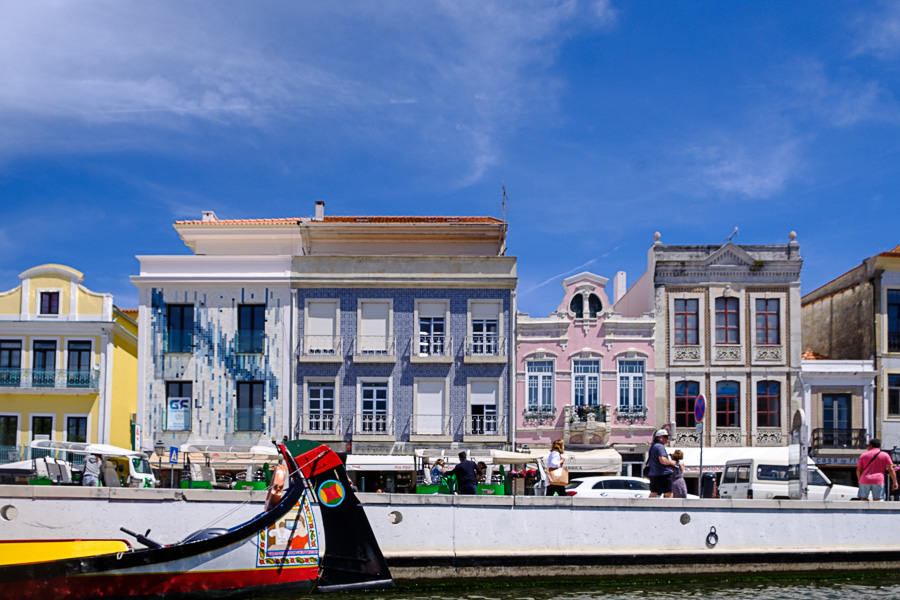Today was a day on the road, first to the canal town of Aveiro and then on to Porto. Driving, navigating, paying tolls and parking are all part of the game. Of course, on a guided tour the bus driver does all that for you. And the guide is there to, well, guide you from the bus to the lobby of the hotel. But no, we’re doing it All By Ourselves.
Getting from the convent at Belmonte to Aveiro was a snap. We filled up the buggy (gasp, darn near $60 for a 3/4 of a tank in a small VW) and hit the A23 to the A25. Close your eyes and you’d think you’re back on Interstate 75.
Google took us right to the canal where they park the moliceiras. There was even a P sign that directed us to a street parking spot. It took a few minutes and the help of a kind gentleman to figure out we needed 1.85 Euros for two hours of parking. We were actually gone for 2:30 so we got a bargain (and no tickets). The lady at the tourism office directed us, sorta, towards the WC across the canal and up the street. All was good.
Aveiro is known for its production of salt, something that has been going on since the time of the Romans. The Moors held the area for a while, exiting, as we’ve seen, in the 12thcentury. There remains only one active salt warehouse in town, down from a dozen or more at the peak. The town is also known for producing seaweed (as a fertilizer) and ceramics. Aveiro is also an important Atlantic Ocean port. The opening of the canals here in the early 1800s reopened shipping, something that had been impeded by shifting barriers at the mouth of Aveiro’s port.
But of course Aveiro’s biggest export is tourism. The big deal is a tour on Aveiro’s canals in moliceiras: open boats originally used to carry salt. You can see from the pictures a vague similarity between moliceiras and Venetian gondolas. Both have canals and both carry mostly tourists. The gondoliers here don’t wear bandanas and fancy hats like they do in Spain and they drive Yamahas rather than polling their boats through the canals.
Aveiro has an ancient history but from what we saw on our ride it’s a thoroughly modern and bustling city. Lots of modern construction, recent and underway. The boat ride was pleasant, about 45 minutes long, with brief commentaries from our boat guide (in Portuguese, French and English; he speaks other languages if need be). The weather continues to be perfect.
After the ride we found an open-air café on the pedestrian thoroughfare. We tried three different establishments. The first specialized in pastries and tapas plates (most under 3 Euros); one that has only “piglet” items on its menu and the third that offers only cod. Judy had cod and potatoes; I had cod with chick peas. The cod was good but salty, reflecting the city’s salt heritage, perhaps.
Then back in the buggy and onto the A25 and A1 for Porto. Porto is the second biggest city in Portugal and its traffic bears witness to that fact. Waze was less than precise, and maybe my driving was lacking too, but we hit the same roundabout three times before getting the correct gozouta (we even traversed a parking ramp in the process).
The hotel had suggested two parking lots, one near the hotel and the other across the river. We passed by the first on our way to the hotel. We noted that the bridge’s pedestrian crossing was narrow and crowded. We found the second lot without too much trouble but finding a parking spot inside it was a challenge. I passed two for being too small, but it’s probably the case that I was too small minded to try.
We really aren’t in a hotel; it’s properly called an apartment. Google got us to within a stone’s throw, but do you know how many buildings there are even within my limited throwing range? A lot. Two inquiries got us close enough. There is no front desk; we were given a front door access code and a code for our mail box, within which was a key. It’s a very nice apartment, complete with kitchen and washing machine. Judy figured that one out before I got logged into wifi.
And whatever the pain we suffered getting here is more than made up by the great location. A block off the river with shops, restaurants and historical sites in every direction. It’s a bustling, happening kind of environment. We once again are several decades beyond the mean tourist age, that’s for sure.
So here I sit typing. Judy’s just back from the grocery mart (where the nice man pointed us in the general direction of our dwelling) with water and cookies.
Now the dilemma: it’s almost 5 PM. Should we brave the traffic and park the car across the river? It’s 30 Euros cheaper. But when we leave on Wednesday, we’d have to schlep our bags across the river. The alternative: leave the car where it is and cross the bridge on foot to the Kopke wine shop recommended by our niece Amy (“nice view of the river and nice flights to taste”). We could come back and stroll the river bank and find a nice place for dinner. Care to guess which way we’re going?
*** Four Hours Later ***
You guessed it – port tasting and dinner by the Duaro River. Let the car luxuriate in the high price digs. We had a great evening.
We tried two places recommended by Amy, but we were too late for both. Fortunately, the parent company of Kopke was still open so we had a five-flight sampling of port wine. Amazingly, Judy liked it! Nice and sweet. After five tastings (we shared a single tasting menu) they could have sold me a Lamborghini. We tried a restaurant with decent reviews just down the street, out on the sidewalk, steak and chicken (enough with the fish, already). It was nice too with the sunset breaking out in all its glory as we paid the bill. But boy, was it cold on these Florida-seasoned limbs. The wind came in gusts down the river and chilled us to the bone.
We’ve hustled back to the apartment and are ready for bed if only for the warmth. This is the first room we’ve had so far without air conditioning and we won’t miss it a bit.
We’re due at the Praça da Liberdadefor the free walking tour – 10:00 AM, which should give us time for a leisurely breakfast at one of the zillion cafes just outside our front door. The Praçais only a 10-minute walk. What we missed in our plaining is that it’s 10 minutes straight up hill. At least we can make a dent in our caloric input this evening.












































